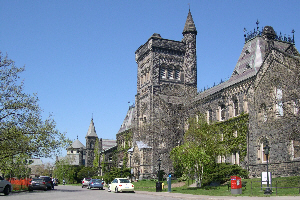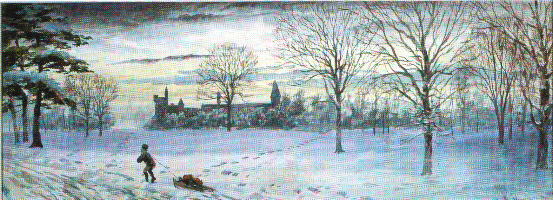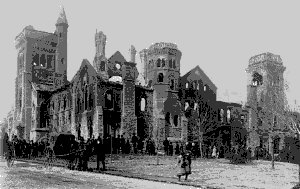University College, which is a national historic site, was built between 1856, and 1859. With its mix of architectural styles, from Norman to Romanesque, this is said to be one of the most photographed buildings in Toronto. Cumberland and Storm were the original architects. In 1890 it suffered a disastrous fire, after which David B. Dick restored it by 1892.

John Graves Simcoe had been in favour of a college in the colony as had many of the United Empire Loyalists who came here after the American Revolution. Simcoe, who had been educated at Oxford, wrote about establishing “a college of a higher class.” John Strachan travelled to England to lobby for permission establish a university. In March of 1826 he was successful and was able to return to Upper Canada with a royal charter.
King’s College, as the university was known then, was located in a series of buildings including the Legislature on Front Street and a building where the present Legislature is. Bishop Strachan wanted the University to be an institution of the Anglican Church, but many disagreed, resulting 25 years of intense conflict on the question of the place of the church in higher education in the colony. He lost. On April 3rd, 1849, Robert Baldwin introduced a bill into the parliament of the province of Canada to convert King’s College into the University of Toronto. It would completely secularize the university.
It had been assumed that with the passing of the Baldwin Act, the University of Toronto would occupy the King’s College property in Queen’s Park and, until it was completed, the legislative building on Front Street. But things did not work out that way because, after fire had destroyed the Montreal parliament building, parliament returned to Toronto for its sittings. The former King’s College building, where the Ontario Legislature now stands, was repossessed by the Province. In the end, Ottawa was selected as the capital, but the old King’s College site was never returned to the University. The building was needed for a women’s mental hospital. There appears to be some strange link between legislatures, universities and insane asylums. The King’s College building, perhaps not inappropriately, was named ‘The University Lunatic Asylum.’
The University was then forced to occupy the newly constructed medical building, which was no longer required for the medical school (the government had eliminated the medical faculty in 1853). The University obviously needed a new building. The construction of the magnificent University College, starting in 1856, would be the answer.

University College from Queen’s Park
by Marmaduke Matthews, c. 1890
This watercolour was a gift from Professor Claude Bissell to the University College Art Collection, University of Toronto in 1959. This watercolour may have been painted about the time that the great fire in February 1890; see below. Here we see UC from the west side of Queen’s Park, viewed along the approach that became Wellesley Street. Trees in the Taddle Creek ravine hide the few buildings erected in the late 19th century in the spacious grounds around the University of Toronto’s “Main Building.” Click for 1860 map. For more about Marmaduke Matthews go to Wychwood Park.

In 1890 tragedy struck. A fire destroyed nearly all of the University College building. Here we see the burned out shell. The one part of UC that escaped this fire was the chemistry lab, now known as the Croft Chapter House after Professor Croft who established the Department of Chemistry. The building was restored; like a phoenix it rose again from its ashes. The University lost its library in the great fire, but Universities throughout the British Empire (now the British Commonwealth) came to the rescue and donated many books. The result was that the University ended up with a larger and better library.
For more about University College and a virtual tour go to www.utoronto.ca/uc/
